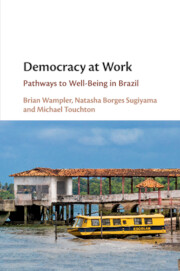Book contents
- Democracy at Work
- Democracy at Work
- Copyright page
- Contents
- Figures
- Tables
- Preface and Acknowledgments
- Interviews
- Abbreviations
- Introduction
- 1 Democracy at Work
- 2 Building Pathways for Change
- 3 Research Design, Methods, and Variables
- 4 Reducing Poverty: Broadening Access to Income
- 5 Improving Health: Saving Lives
- 6 Empowering Women: Saving Mothers and Enhancing Opportunities
- 7 Educating Society: Promoting Public Education and Learning
- 8 Pathways at Work: Lessons from Brazil’s Poor Northeast
- Conclusion
- Appendix Democracy at Work Pathways to Well-Being in Brazil
- References
- Index
Introduction
Published online by Cambridge University Press: 28 September 2019
- Democracy at Work
- Democracy at Work
- Copyright page
- Contents
- Figures
- Tables
- Preface and Acknowledgments
- Interviews
- Abbreviations
- Introduction
- 1 Democracy at Work
- 2 Building Pathways for Change
- 3 Research Design, Methods, and Variables
- 4 Reducing Poverty: Broadening Access to Income
- 5 Improving Health: Saving Lives
- 6 Empowering Women: Saving Mothers and Enhancing Opportunities
- 7 Educating Society: Promoting Public Education and Learning
- 8 Pathways at Work: Lessons from Brazil’s Poor Northeast
- Conclusion
- Appendix Democracy at Work Pathways to Well-Being in Brazil
- References
- Index
Summary
One of the greatest challenges in the twenty-first century is to address large, deep, and historic deficits in human development. A crucial question we explore in this book is how democracy – with all of its messy, contested, and time-consuming features – works to advance well-being and improve citizens’ lives. Broad evidence demonstrates that democracies provide more public goods and higher standards of living, on average, for citizens than authoritarian countries (Przeworski et al. 1999: 264–265; Lake and Baum 2001; Besley and Kudamatsu 2006; Brown and Mobarak 2009; Acemoglu et al. 2013; Harding and Stasavage 2014; Hodgson 2017; Gerring et al. 2015). We move beyond the conventional explanations – elections, political competition, and partisanship – to develop theory connecting core dimensions of democracy – participation, citizenship, and an inclusive state – to improvements in well-being. In doing so, we illuminate how these dimensions form “pathways” that help citizens and governments achieve better human development outcomes.
- Type
- Chapter
- Information
- Democracy at WorkPathways to Well-Being in Brazil, pp. 1 - 21Publisher: Cambridge University PressPrint publication year: 2019



